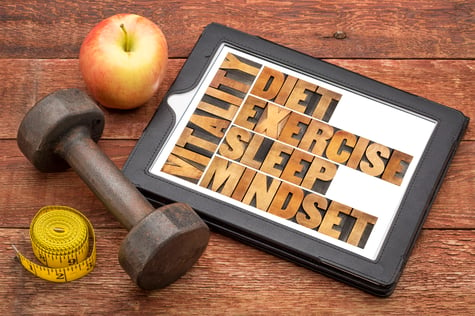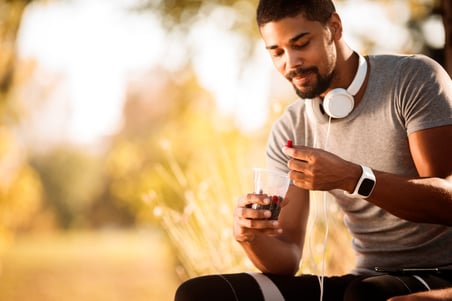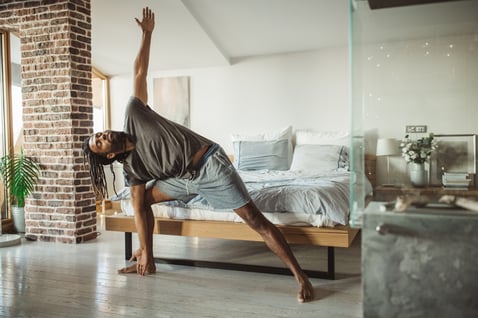 Sometimes you might think you’re doing the right things (or at least not really wrong things) when it comes to healthy eating. But those habitual behaviors might actually cause you to consume more food and calories.
Sometimes you might think you’re doing the right things (or at least not really wrong things) when it comes to healthy eating. But those habitual behaviors might actually cause you to consume more food and calories.
Not-So-Healthy Habit #1: Eating Too Quickly
You might have heard that it takes approximately 20 minutes for your body to send a signal to your brain that it is full. While the exact amount of time likely varies from person to person and the amount of food consumed, it is typically true that satiety doesn’t occur immediately after consuming something. Therefore, if you’re still hungry right after after eating something, you should allow yourself a few minutes to see whether satiety kicks in, or if you truly are still hungry. Additionally, eating too quickly can cause you to swallow air, which may result in GI discomfort such as gas or bloating, and also poses a risk for choking.
THE FIX: To help slow down the rate at which you eat, try taking smaller bites, chewing more slowly and thoroughly, putting your utensil down between bites, including sips of water between bites, and making conversation throughout the meal if eating with others.
Not-So-Healthy Habit #2: Skipping Meals
Overeating can also result from skipping meals or following irregular eating patterns. For example, some individuals may use compensatory thinking after skipping meals, such as, “I didn’t eat anything all day, so it is okay for me to eat whatever I want tonight.” Similarly, skipping meals may lower your inhibitions, making it more likely for you to choose unhealthier food options. Skipping meals can disrupt your metabolism, blood-sugar levels, and mental and physical performance.
THE FIX: To prevent skipping meals, it’s important to establish a regular eating schedule. There is no “one-size-fits-all” perfect eating regimen: three meals a day may suffice for some, while others prefer five or six “mini meals” or snacks. If an irregular appetite is the issue causing you to skip meals, try eating smaller, more frequent meals throughout the day. If you find that time is the problem, plan your meals and snacks in advance (for example, the night before) and keep plenty of portable snacks on hand (such as granola bars, apples, oranges, and trail mix).
Not-So-Healthy Habit #3: Eating While Distracted
Similar to when an individual eats too quickly, eating while distracted may interfere with the body’s ability to signal satiety to the brain, thus increasing the odds of overeating. If you aren’t focusing on what you are eating and how you feel while you are eating, you might not recognize when you’ve had enough.
THE FIX: The next time you’re eating a snack or meal, be sure to sit down in a quiet, comfortable setting and unplug from all distractions such as your cell phone, computer, or TV.
Not-So-Healthy Habit #4: Over-restricting Intake
Over-restricting your intake can also lead to overeating. For many people, the idea of not being able to have something only makes them want it more. The same is true with food. Restricting certain food groups can also restrict certain nutrients that your body needs to function properly. For example, when an individual aims to restrict all carbohydrates, they are also restricting the good components of carbohydrates, such as fiber, vitamins, and minerals.
THE FIX: Instead of banishing the foods you love and depriving yourself of them, try allowing yourself to have them more frequently—just in moderation. For example, if you’re someone who finds yourself swearing to never eat ice cream again at the top of every week, only to find yourself indulging in an entire pint by Friday, try allowing yourself a small bowl or serving of ice cream several times each week to satisfy your cravings.
***
If you’re working on practicing healthy eating, try to be mindful about your eating habits, plan ahead, and give yourself some grace.
This blog was written by Lindsey Recker, MS, Registered Dietitian. To learn more about the NIFS bloggers, click here.


 1. Do make a plan to manage your stress level.
1. Do make a plan to manage your stress level. Let’s be real. We aren’t always motivated to work out, and sometimes it’s hard to find that motivation. It’s even harder to find motivation when you don’t even enjoy exercise. It’s important to learn why getting active is so important, and it all starts with changing your mindset about it.
Let’s be real. We aren’t always motivated to work out, and sometimes it’s hard to find that motivation. It’s even harder to find motivation when you don’t even enjoy exercise. It’s important to learn why getting active is so important, and it all starts with changing your mindset about it.  With the phrase “freshman 15” commonly tossed around, many students enter college with a fear or perception that they will gain weight. However, a
With the phrase “freshman 15” commonly tossed around, many students enter college with a fear or perception that they will gain weight. However, a 
 Let’s be real: a health journey is not always linear and not always easy. Sometimes it can be overwhelming and mucky. What do you do? Where do you start? What if you backslid and need to get back on track? There is so much to health, right? If you try to fix it all at once, you might become overwhelmed and at a greater risk of failure.
Let’s be real: a health journey is not always linear and not always easy. Sometimes it can be overwhelming and mucky. What do you do? Where do you start? What if you backslid and need to get back on track? There is so much to health, right? If you try to fix it all at once, you might become overwhelmed and at a greater risk of failure. 



 These past few weeks have been trying times for not only our families and friends, but also for the athletes we engage with on a daily basis throughout the year. In our position we must stay in a lead-by-example mentality. If we let ourselves go during this time, our athletes will notice and do the exact same thing. This is definitely a time of uncertainty and there are a lot of unknowns. Controlling what we can control on a daily basis is what will help not just us personally, but also those around us, to get through and come out of this on top.
These past few weeks have been trying times for not only our families and friends, but also for the athletes we engage with on a daily basis throughout the year. In our position we must stay in a lead-by-example mentality. If we let ourselves go during this time, our athletes will notice and do the exact same thing. This is definitely a time of uncertainty and there are a lot of unknowns. Controlling what we can control on a daily basis is what will help not just us personally, but also those around us, to get through and come out of this on top. Personal trainers are people, too (well, at least when no one is looking!). In reality, there are a lot of new bridges we, as a society, are crossing every single day. As a trainer, my goal is to put all my effort into making sure that my clients are being healthy with fitness and wellness as a priority. With the lockdown upon us, finding new ways to get this job done is a challenge, but so is making sure that you are finding time for yourself.
Personal trainers are people, too (well, at least when no one is looking!). In reality, there are a lot of new bridges we, as a society, are crossing every single day. As a trainer, my goal is to put all my effort into making sure that my clients are being healthy with fitness and wellness as a priority. With the lockdown upon us, finding new ways to get this job done is a challenge, but so is making sure that you are finding time for yourself.  There are no definitive right answers on how we are supposed to individually succeed during a pandemic. We all cope, struggle, and win the day in our own ways. We can all feel a little lost and confused at times, and that’s completely normal as we cross bridges into territory we have never experienced in our lives.
There are no definitive right answers on how we are supposed to individually succeed during a pandemic. We all cope, struggle, and win the day in our own ways. We can all feel a little lost and confused at times, and that’s completely normal as we cross bridges into territory we have never experienced in our lives.